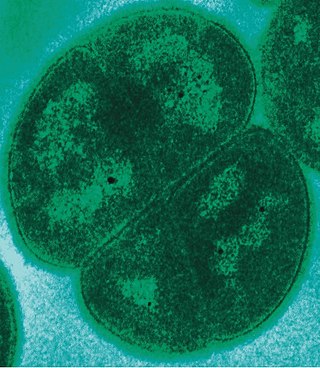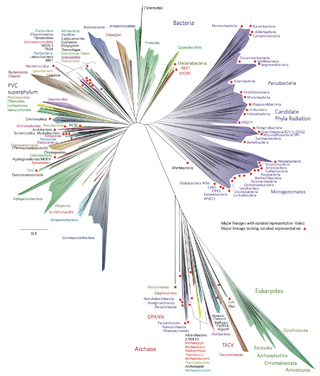| Borreliaceae | |
|---|---|
| Scientific classification | |
| Domain: | Bacteria |
| Phylum: | Spirochaetota |
| Class: | Spirochaetia |
| Order: | Spirochaetales |
| Family: | Borreliaceae Gupta et al. 2014 [1] |
| Genera | |
| |
The Borreliaceae are a family of spirochete bacteria.
| Borreliaceae | |
|---|---|
| Scientific classification | |
| Domain: | Bacteria |
| Phylum: | Spirochaetota |
| Class: | Spirochaetia |
| Order: | Spirochaetales |
| Family: | Borreliaceae Gupta et al. 2014 [1] |
| Genera | |
| |
The Borreliaceae are a family of spirochete bacteria.

A spirochaete or spirochete is a member of the phylum Spirochaetota, which contains distinctive diderm (double-membrane) gram-negative bacteria, most of which have long, helically coiled cells. Spirochaetes are chemoheterotrophic in nature, with lengths between 3 and 500 μm and diameters around 0.09 to at least 3 μm.

The Bacillota are a phylum of bacteria, most of which have gram-positive cell wall structure. The renaming of phyla such as Firmicutes in 2021 remains controversial among microbiologists, many of whom continue to use the earlier names of long standing in the literature.

Chromista is a biological kingdom consisting of single-celled and multicellular eukaryotic species that share similar features in their photosynthetic organelles (plastids). It includes all protists whose plastids contain chlorophyll c, such as some algae, diatoms, oomycetes, and protozoans. It is probably a polyphyletic group whose members independently arose as a separate evolutionary group from the common ancestor of all eukaryotes. As it is assumed the last common ancestor already possessed chloroplasts of red algal origin, the non-photosynthetic forms evolved from ancestors able to perform photosynthesis. Their plastids are surrounded by four membranes, and are believed to have been acquired from some red algae.
The Aquificota phylum is a diverse collection of bacteria that live in harsh environmental settings. The name Aquificota was given to this phylum based on an early genus identified within this group, Aquifex, which is able to produce water by oxidizing hydrogen. They have been found in springs, pools, and oceans. They are autotrophs, and are the primary carbon fixers in their environments. These bacteria are Gram-negative, non-spore-forming rods. They are true bacteria as opposed to the other inhabitants of extreme environments, the Archaea.

Deinococcota is a phylum of bacteria with a single class, Deinococci, that are highly resistant to environmental hazards, also known as extremophiles. These bacteria have thick cell walls that give them gram-positive stains, but they include a second membrane and so are closer in structure to those of gram-negative bacteria.

The phylum Bacteroidota is composed of three large classes of Gram-negative, nonsporeforming, anaerobic or aerobic, and rod-shaped bacteria that are widely distributed in the environment, including in soil, sediments, and sea water, as well as in the guts and on the skin of animals.

Acidobacteriota is a phylum of Gram-negative bacteria. Its members are physiologically diverse and ubiquitous, especially in soils, but are under-represented in culture.
The Thermotogota are a phylum of the domain Bacteria. The phylum Thermotogota is composed of Gram-negative staining, anaerobic, and mostly thermophilic and hyperthermophilic bacteria.

Enoplea (enopleans) is a class, which with the classes Secernentea and Chromadorea make up the phylum Nematoda in current taxonomy. The Enoplea are considered to be a more ancestral group than the Chromadorea, and researchers have referred to its members as the "ancestrally diverged nematodes", compared to the "more recently diverged nematodes" of Chromadorea.
The Gemmatimonadota are a phylum of bacteria established in 2003. The phylum contains two classes Gemmatimonadetes and Longimicrobia.
The Synergistota is a phylum of anaerobic bacteria that show Gram-negative staining and have rod/vibrioid cell shape. Although Synergistota have a diderm cell envelope, the genes for various proteins involved in lipopolysaccharides biosynthesis have not yet been detected in Synergistota, indicating that they may have an atypical outer cell envelope. The Synergistota inhabit a majority of anaerobic environments including animal gastrointestinal tracts, soil, oil wells, and wastewater treatment plants and they are also present in sites of human diseases such as cysts, abscesses, and areas of periodontal disease. Due to their presence at illness related sites, the Synergistota are suggested to be opportunistic pathogens but they can also be found in healthy individuals in the microbiome of the umbilicus and in normal vaginal flora. Species within this phylum have also been implicated in periodontal disease, gastrointestinal infections and soft tissue infections. Other species from this phylum have been identified as significant contributors in the degradation of sludge for production of biogas in anaerobic digesters and are potential candidates for use in renewable energy production through their production of hydrogen gas. All of the known Synergistota species and genera are presently part of a single class (Synergistia), order (Synergistiales), and family (Synergistaceae).
Mycoplasmatota is a phylum of bacteria that contains the class Mollicutes. The phylum was originally named "Tenericutes". Notable genera include Mycoplasma, Spiroplasma, Ureaplasma, and Candidatus Phytoplasma.
The Chloroflexota are a phylum of bacteria containing isolates with a diversity of phenotypes, including members that are aerobic thermophiles, which use oxygen and grow well in high temperatures; anoxygenic phototrophs, which use light for photosynthesis ; and anaerobic halorespirers, which uses halogenated organics as electron acceptors.
In biology, a phylum is a level of classification or taxonomic rank below kingdom and above class. Traditionally, in botany the term division has been used instead of phylum, although the International Code of Nomenclature for algae, fungi, and plants accepts the terms as equivalent. Depending on definitions, the animal kingdom Animalia contains about 31 phyla, the plant kingdom Plantae contains about 14 phyla, and the fungus kingdom Fungi contains about 8 phyla. Current research in phylogenetics is uncovering the relationships between phyla, which are contained in larger clades, like Ecdysozoa and Embryophyta.

The nematodes or roundworms constitute the phylum Nematoda, with plant-parasitic nematodes also known as eelworms. They are a diverse animal phylum inhabiting a broad range of environments. Less formally, they are categorized as Helminths, but are taxonomically classified along with arthropods, tardigrades and other moulting animals in the clade Ecdysozoa, and unlike flatworms, have tubular digestive systems with openings at both ends. Like tardigrades, they have a reduced number of Hox genes, but their sister phylum Nematomorpha has kept the ancestral protostome Hox genotype, which shows that the reduction has occurred within the nematode phylum.
Lentisphaerota is a phylum of bacteria closely related to Chlamydiota and Verrucomicrobiota.

Bacterial phyla constitute the major lineages of the domain Bacteria. While the exact definition of a bacterial phylum is debated, a popular definition is that a bacterial phylum is a monophyletic lineage of bacteria whose 16S rRNA genes share a pairwise sequence identity of ~75% or less with those of the members of other bacterial phyla.

Xenacoelomorpha is a small phylum of bilaterian invertebrate animals, consisting of two sister groups: xenoturbellids and acoelomorphs. This new phylum was named in February 2011 and suggested based on morphological synapomorphies, which was then confirmed by phylogenomic analyses of molecular data.

Pisuviricota is a phylum of RNA viruses that includes all positive-strand and double-stranded RNA viruses that infect eukaryotes and are not members of the phylum Kitrinoviricota,Lenarviricota or Duplornaviricota. The name of the group is a syllabic abbreviation of “picornavirus supergroup” with the suffix -viricota, indicating a virus phylum. Phylogenetic analyses suggest that Birnaviridae and Permutotetraviridae, both currently unassigned to a phylum in Orthornavirae, also belong to this phylum and that both are sister groups. Another proposed family of the phylum is unassigned Polymycoviridae in Riboviria.
Gracilibacteria is a bacterial candidate phylum formerly known as GN02, BD1-5, or SN-2. It is part of the Candidate Phyla Radiation and the Patescibacteria group.